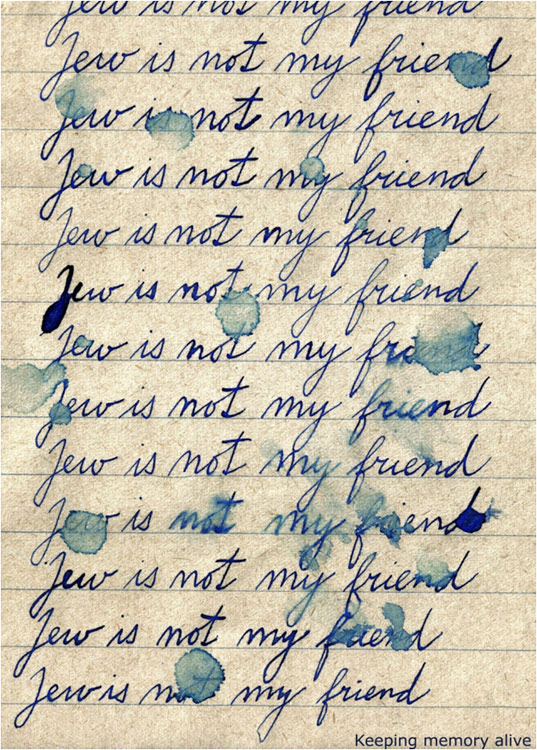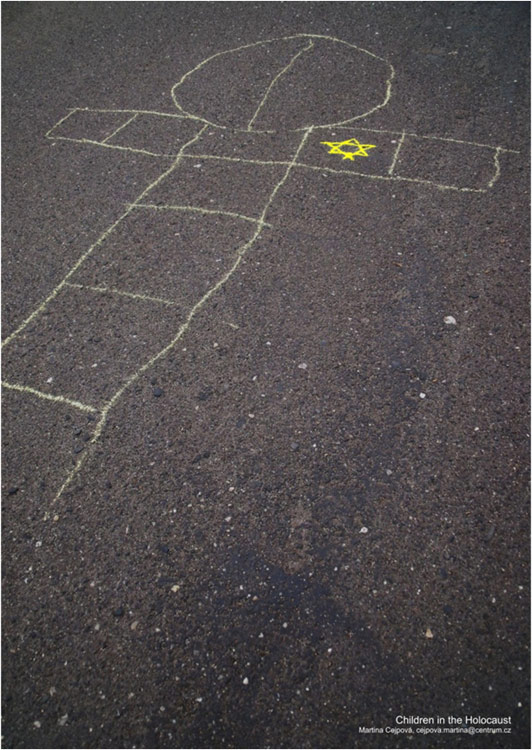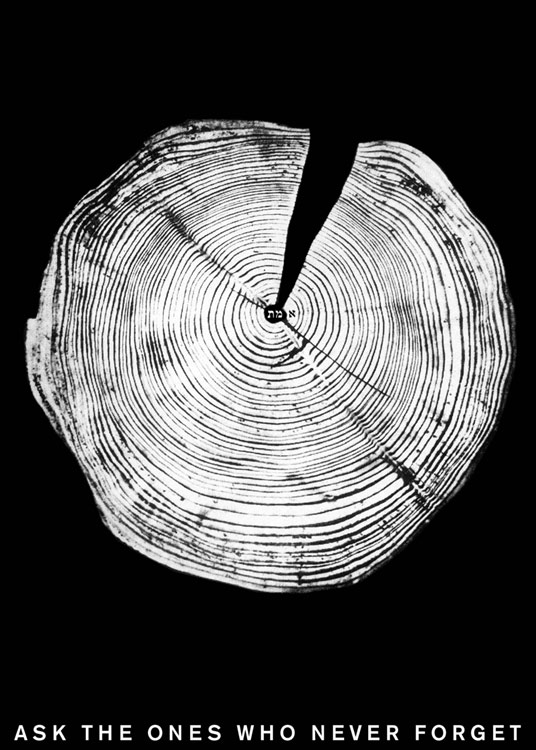Veronica Novakova (Czech Republic), Boris Grzeszcak (France) and Martina Cejpova (Czech Republic) are the three finalists of the International Holocaust Poster competition 2012, a joint project of Yad Vashem and the Holocaust and the United Nations Outreach Programme.
Introduction
Posters have been used for more than 150 years to grab our attention. Visually arresting, incorporating graphics and typography, posters convey a strong, succinct message meant to move those that see them. They deliver a punch, a thought, an idea that can be instantly understood, absorbed and reacted to by their audience. As an art form, posters are ubiquitous and accessible - appearing in multiples, covering public surfaces from walls to light posts, visible to all. They are, by their very nature, extremely current. They draw attention to an event, political message or product, which may change or be gone in the following days or weeks. They offer fresh perspectives on old themes. It is this cutting- edge nature of the poster that makes them so exciting – they reflect the here and now.
For these reasons, the Task Force for International Cooperation on Holocaust Education, Remembrance and Research (ITF) , Yad Vashem and the Mémorial de la Shoah have chosen this art form as a way to explore Holocaust memory. In late 2010-early 2011, an international poster competition was held, the theme being Holocaust commemoration, with an emphasis on the nature of memory and the plight of children. Sixteen finalists and three top winners were chosen by an international panel of judges. The finalists’ work appears in this lesson plan.
For educators, we feel these award-winning posters offer an excellent gateway to help students examine the nature of memory and commemoration. Through their use, educators and students can discuss the individual messages these international designers convey in their works. Beyond these specific posters we also offer a lesson plan to provide students and teachers tools to discuss the more universal aspects of memory and the challenges facing those who choose to use the visual arts to commemorate the Holocaust today.
Three Winning Posters
The three finalists of the international Holocaust poster competition designed posters which stood out for their originality, beauty, and meaning.
Veronica Novakova
Veronica Novakova, a designer from the Czech Republic, chose to deal with the theme of children in the Holocaust. Her work portrays a traditional childhood punishment, recognizable and relatable to many people from their own childhood. Traditionally, to correct a child’s errant behavior, an adult will force the “naughty” child to write his misdeed over and over again, until he “learns his lesson.”
In this case, the misdeed is written by a child who is forced to denounce his friendship with a Jewish friend. Under anti-Jewish legislation adopted in Germany and other countries, Jews were ostracized from all spheres of daily life. The everyday contact they once enjoyed with their friends and neighbors became forbidden, turning Jews into pariahs. These restrictive laws were created by adults to enforce their own anti-semitic ideology. Children, in their innocence, could neither understand the ideology nor the hatred behind these laws which were forced on them from the adult world; for children, these laws meant that a beloved playmate inexplicably became untouchable, forbidden, and lost to them. Worse still, trying to maintain that friendship resulted in punishment. Veronica addresses the effect this enforced hatred takes on an innocent child in her poster. She shows us a punishment list in which a child is forced to denounce his friendship again and again. Beyond the hurtful words, the true feelings of the heartbroken writer are revealed in a very touching way – the list is splattered and blurred by tears.
Martina Cejpova
Designer Martina Cejpova also explores the effect the Nazi anti-Jewish policy had on children. In her poster, she depicts a universally-recognized image from childhood: a hopscotch board, chalked onto the pavement. This particular game, however, is marred by a hateful symbol of discrimination drawn onto its cross-arms – the yellow star. Its inclusion here indicates that the insidious and pervasive hatred perpetrated by the adult world has also filtered down to the world of children, destroying their innocence. We are left to wonder who drew this hopscotch board: Jewish children reflecting the star which brands them, even in their play, or non-Jewish children creating a discriminating alternative to their own star-free game. One thing remains clear – the creator of this hopscotch board has been deeply affected by adult decisions.
French Designer Boris Grzeszcak deals with another theme in his work – the nature of memory. His black-and-white poster presents a striking image of a scarred tree cut to expose the rings. A deep gash cuts to the very core of the trunk, where the word “emet” is written in tiny letters. The designer tells us:
Boris Grzeszcak
Here, there is a misunderstanding between historic time and natural time. The rings of the tree always hold the memory of the past, and I noticed that often, former concentration and extermination camps are located in forests. To quote an old Jewish wise man “we don’t cut the tree to have a fruit”. The poster is paradoxical since there is a reflection of the fruits, which will lead to a just memory. On the outside, the tree’s years, emotions, and tragedies disappear. All that is permanent resides in the fact that cutting a tree represents the echoing of the irreparable crimes of the Nazis. The Hebrew writing in the center of the trunk tells the story of the Golem in which Rabbi Loew writes "Emet" (truth), so that it could give him life. In order to take life away from him, he only deleted the aleph, leaving [the letters] “Mem” [and "Taph"] which signifies death. “Aleph”, (the letter of continuity) is found within the trunk, where the memory is inscribed. The truth resides in the act of remembering and above all, never forgetting these dramatic events. The big notch in the trunk (which also gives the appearance of a clock) portrays for us the unique character of the Holocaust, a true rupture in history, a radical break, a unique event which took away part of man’s humanity. This notch also directs us to the Hebrew word written at the center which signifies death.
The winning posters in this competition work on many levels. All are visually striking and beautiful in their design, and as such can be appreciated in a purely aesthetic sense. Beyond their beauty, the posters engage viewers and draw them in by using universally relatable themes and packing a punch which leaves the viewers moved by what they see.









